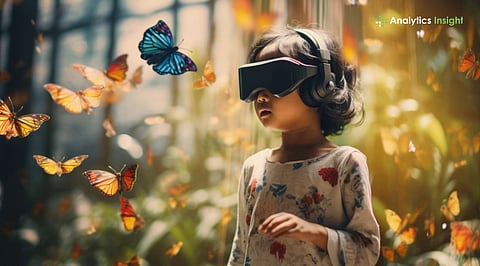

VR and AI can enhance empathy, but must not replace authentic human emotional experiences.
Balanced integration of technology and real-world interaction ensures healthy emotional and moral growth.
Ethical design and parental involvement are vital to prevent emotional manipulation by digital systems.
The next generation, often referred to as Gen Z, is growing up with virtual reality goggles and intelligent companions. Simulation experiences have become a significant part of their development. Unlike previous generations, they rely less on human interaction, outdoor play, and traditional forms of learning.
While the use of VR and AI in teaching can foster empathy and nurture kindness, the question arises: are these tools helping them, or are they simply conditioning their minds to seek and rely on artificial affirmation?
Children’s perception, education, and interactions with the world are being revolutionized by virtual reality (VR) technology. Children experience VR differently, such as walking on Mars or swimming in the ocean, rather than using a book or directly playing with "play."
As a result, children are immersed in new experiences, which helps enhance their imagination, curiosity, and cognitive process. However, it also changes how children construct their perception of reality.
Children may struggle to distinguish between what is genuine and what is an illusion when they experience life events digitally. The use of digital characters and continuous gamified learning could help children become more focused and adaptive.
On the other hand, there’s a risk they will be less sensitive to real-world emotions. It is crucial that, with expert assistance, VR expands children’s imagination without totally severing their connection to the actual world.
Also Read: How AR and VR Are Changing Exercise with Gamified Workouts?
AI-powered virtual reality systems can simulate real-life social situations, such as conflict resolution, teamwork, and empathy exercises, and provide immediate feedback on kids’ emotional reactions.
To illustrate, a VR classroom may feature avatars that express sadness or anger, allowing a kid to practice in a controlled environment. That said, it can be highly advantageous for children with special needs who struggle to read social cues.
However, there’s a fine line between teaching and manipulating. When computers begin to shape a child’s emotional responses, they risk creating automatic, conditioned reactions rather than genuine emotions.
Therefore, cultivating emotional intelligence requires finding the right balance - one where technology supports rather than dictates development.
The very advances of VR and AI have highlighted the conflict between parents’ guidance and technological influence. Usually, parents would mold kids’ characters, imparting values, ethics, and emotional intelligence through personal examples.
At the same time, AI educators, digital classrooms, and online mentors are increasingly shaping how young people think. They create customized educational materials, monitor emotions, and suggest behavioral changes, often independent from parents. This creates a serious dilemma: Who has the greater influence, the caregiver or the code?
To secure moral development in a child, parents must set ethical limits beyond educational technology, communicating what is authentic and what is not.
Virtual reality and artificial intelligence can greatly support children in developing kindness by allowing them to feel and experience things virtually. But technology cannot replace the intimacy, richness, and serendipity of a real person.
Even if these systems facilitate empathetic conversations, they cannot replace the comfort of a genuine human connection.
We must ensure that this generation’s growth of kindness and character is not influenced by technology as they grow up. A healthy balance depends on the combination of human connection and digital learning.
How does VR influence emotional development in children?
VR can increase empathy by placing children in real-life situations, making them comprehend multiple viewpoints. Excessive exposure, though, may confuse the boundaries between the real and the simulated, thus requiring a balance between virtual learning and authentic human interactions and experiences.
Is AI-driven learning a potential substitute for classical parenting and schooling?
AI technology can enhance customized learning and emotional development, but cannot substitute the warmth and ethical foundation of human direction. Parents and educators need to engage actively so that technology aids emotional and ethical development, rather than overpowering it.
What are the dangers of early VR exposure for children?
Overuse of VR can result in decreased real-world empathy, eye strain, and reliance on virtual environments. Kids need to experience real-world playtime and interactions to preserve emotional richness, creativity, and physical health alongside virtual discovery.
How do parents balance VR and the real world?
Parents must monitor screen time, engage in VR activities, and discuss real-life analogs. Promoting outdoor play, creative pursuits, and socialization ensures that VR becomes a tool for development rather than a replacement for real learning and bonding.
Is it possible that VR and AI can truly foster empathy in children?
Responsible use of VR and AI is able to foster empathy by recreating a variety of life experiences. Empathy, however, has to be supported through meaningful relationships and emotional discussions so that children develop kindness with real-life understanding, not algorithmic training.
